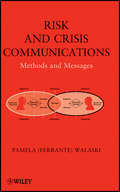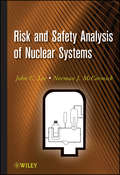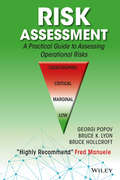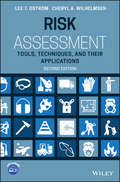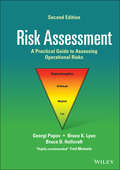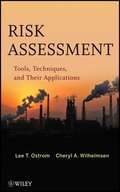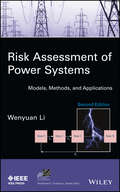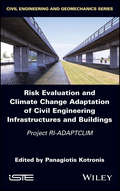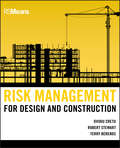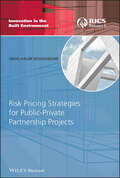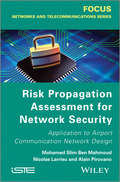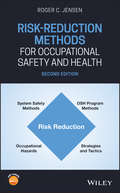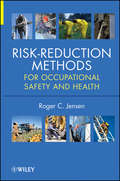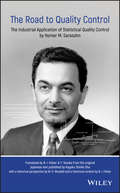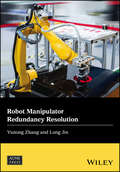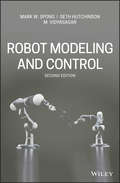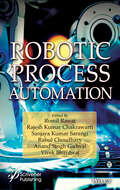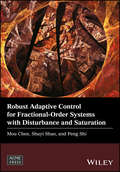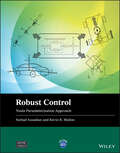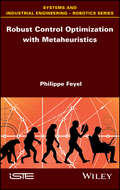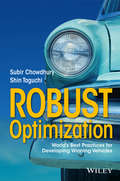- Table View
- List View
Risk and Crisis Communications
by Pamela Ferrante WalaskiThe go-to guide for learning what to say and how to say it In this climate of near constant streams of media messages, organizations need to know how to effectively communicate risks to their audiences and what to say when a crisis strikes. Risk and Crisis Communications: Methods and Messages is designed to help organizations understand the essential components of communicating about risks during a crisis, and it carves out a role for safety health and environmental (SH&E) professionals in the process. Covering common theoretical concepts and explaining the positions of noted experts in the field such as Peter Sandman and Vincent Covello, the book provides a fundamental understanding of the process behind crafting effective messages for a variety of different situations and explains the consequences of saying the wrong thing to an emotional audience. Incorporating numerous case studies-including the BP Deepwater Horizon Oil Spill and the 2010 H1N1 pandemic-it shows how messages can change the way an audience perceives an event and how they react to it, clearly demonstrating how ineffective messages can create untold difficulties for an organization's public image. Savvy SH&E professionals know that their role in helping to craft risk and crisis messages as well as assisting in the execution of risk communication plans provides a critical path to becoming more valuable members of their organizations. Risk and Crisis Communications: Methods and Messages provides invaluable assistance in helping SH&E professionals add value to their organization.
Risk and Safety Analysis of Nuclear Systems
by John C. Lee Norman J. MccormickThe book has been developed in conjunction with NERS 462, a course offered every year to seniors and graduate students in the University of Michigan NERS program. The first half of the book covers the principles of risk analysis, the techniques used to develop and update a reliability data base, the reliability of multi-component systems, Markov methods used to analyze the unavailability of systems with repairs, fault trees and event trees used in probabilistic risk assessments (PRAs), and failure modes of systems. All of this material is general enough that it could be used in non-nuclear applications, although there is an emphasis placed on the analysis of nuclear systems. The second half of the book covers the safety analysis of nuclear energy systems, an analysis of major accidents and incidents that occurred in commercial nuclear plants, applications of PRA techniques to the safety analysis of nuclear power plants (focusing on a major PRA study for five nuclear power plants), practical PRA examples, and emerging techniques in the structure of dynamic event trees and fault trees that can provide a more realistic representation of complex sequences of events. The book concludes with a discussion on passive safety features of advanced nuclear energy systems under development and approaches taken for risk-informed regulations for nuclear plants.
Risk Assessment: A Practical Guide to Assessing Operational Risks
by Georgi Popov Bruce Hollcroft Bruce K. LyonCovers the fundamentals of risk assessment and emphasizes taking a practical approach in the application of the techniques Written as a primer for students and employed safety professionals covering the fundamentals of risk assessment and emphasizing a practical approach in the application of the techniques Each chapter is developed as a stand-alone essay, making it easier to cover a subject Includes interactive exercises, links, videos, and downloadable risk assessment tools Addresses criteria prescribed by the Accreditation Board for Engineering and Technology (ABET) for safety programs
Risk Assessment: Tools, Techniques, and Their Applications
by Lee T. Ostrom Cheryl A. WilhelmsenSince the first edition of the book was published there have been several changes in the types of risk individuals, businesses, and governments are being exposed to. Cyber-attacks are more frequent and costly and lone-wolf style terrorist attacks are more common; events not addressed in the first edition. The book continues to provide a resource that leads the reader through a risk assessment and shows them the proper tools to be used at the various steps in the process. This book also provides students studying safety and risk assessment a resource that assists them in understanding the various risk assessment tools and presents readers with a toolbox of techniques that can be used to aid them in analyzing conceptual designs, completed designs, procedures and operational risk. On top of the ten new chapters the new edition also includes expanded case studies and real-life examples; coverage on risk assessment software like SAPPHIRE and RAVEN; and end-of-chapter questions for students with a solutions manual for academic adopters. The approach to the book remains the same and is analogous to a toolkit. The user locates the tool that best fits the risk assessment task they are performing. The chapters of the book progress from the concept of risk, through the simple risk assessment techniques, and into the more complex techniques. In addition to discussing the techniques, this book presents them in a form that the readers can readily adapt to their particular situation. Each chapter, where applicable, presents the technique discussed in that chapter and demonstrates how it is used.
Risk Assessment: A Practical Guide to Assessing Operational Risks
by Georgi Popov Bruce K. Lyon Bruce D. HollcroftRisk Assessment Explore the fundamentals of risk assessment with references to the latest standards, methodologies, and approaches The Second Edition of Risk Assessment: A Practical Guide to Assessing Operational Risks delivers a practical exploration of a wide array of risk assessment tools in the contexts of preliminary hazard analysis, job safety analysis, task analysis, job risk assessment, personnel protective equipment hazard assessment, failure mode and effect analysis, and more. The distinguished authors discuss the latest standards, theories, and methodologies covering the fundamentals of risk assessments, as well as their practical applications for safety, health, and environmental professionals with risk assessment responsibilities. “What If”/Checklist Analysis Methods are included for additional guidance. Now in full color, the book includes interactive exercises, links, videos, and online risk assessment tools that can be immediately applied by working practitioners. The authors have also included: Material that reflects the latest updates to ISO standards, the ASSP Technical Report, and the ANSI Z590.3 Prevention through Design standard New hazard phrases for chemical hazards in the Globally Harmonized System, as well as NIOSH’s new occupational exposure banding tool The new risk-based approach featured in the NAVY IH Field Manual New chapters covering business continuity, causal factors analysis, and layers of protection analysis and barrier analysis An indispensable resource for employed safety professionals in a variety of industries, business leaders and staff personnel with safety responsibilities, and environmental engineers Risk Assessment: A Practical Guide to Assessing Operational Risks is also useful for students in safety, health, and environmental science courses.
Risk Assessment
by Lee T. Ostrom Cheryl A. WilhelmsenAll the tools needed to perform a thorough risk assessment-whether you're working in insurance, forensics, engineering, or public safetyRisk analysis is the method of analyzing the dangers to individuals, businesses, and government agencies posed by potential natural and man-made hazards. The central task of the risk assessor is predicting the success of a project. This includes isolating the entire spectrum of adverse events that can derail a project or threaten the health and safety of individuals, organizations, and the environment. Designed as a practical, in-the-field toolkit, Risk Assessment details every aspect of how a risk assessment is performed, showing the proper tool to be used at various steps in the process, as well as locating the tool that best fits the risk assessment task at hand. Examining not only the very nature of risks and consequences, with fascinating historical examples, the book progresses from simple to more complex risk assessment techniques used by the authors in their daily work, all presented in a form that can be readily adapted to any number of real-life situations: Ecological Risk Assessment Task Analysis Techniques Preliminary Hazards Analysis Failure Mode and Effects Analysis Human Reliability Analysis Critical Incident TechniqueWith numerous industry-specific case studies, as well as additional case studies for risk assessments for a restaurant and a process plant, the book provides readers with complete examples of how each of the techniques can be used in a variety of real-world situations. Including downloadable worksheets and other useful assessment materials, as well as guidance on using PRA software, this unparalleled reference offers all the tools and techniques needed to conduct a thorough and accurate assessment of risk.
Risk Assessment of Power Systems: Models, Methods, and Applications (IEEE Press Series on Power Engineering)
by Wenyuan LiExtended models, methods, and applications in power system risk assessment Risk Assessment of Power Systems: Models, Methods, and Applications, Second Edition fills the gap between risk theory and real-world application. Author Wenyuan Li is a leading authority on power system risk and has more than twenty-five years of experience in risk evaluation. This book offers real-world examples to help readers learn to evaluate power system risk during planning, design, operations, and maintenance activities. Some of the new additions in the Second Edition include: New research and applied achievements in power system risk assessment A discussion of correlation models in risk evaluation How to apply risk assessment to renewable energy sources and smart grids Asset management based on condition monitoring and risk evaluation Voltage instability risk assessment and its application to system planning The book includes theoretical methods and actual industrial applications. It offers an extensive discussion of component and system models, applied methods, and practical examples, allowing readers to effectively use the basic concepts to conduct risk assessments for power systems in the real world. With every original chapter updated, two new sections added, and five entirely new chapters included to cover new trends, Risk Assessment of Power Systems is an essential reference.
Risk Evaluation And Climate Change Adaptation Of Civil Engineering Infrastructures And Buildings: Project RI-ADAPTCLIM
by Panagiotis KotronisThis book brings together a selection of the scientific results of the RI ADAPTCLIM project (International Network on Risk Assessment and Climatic Adaptation of Civil Engineering and Buildings Works). Funded by the Pays de la Loire region in France as part of the 2014 Stratégie Internationale call for projects, research teams from the scientific group LiRGeC (ECN, UN, IFSTTAR, CSTB) and several international partners contributed their human, experimental and digital resources. RI-ADAPTCLIM was established to study the short- and medium term effects of climatic conditions on buildings, infrastructures and the ground. Following an integrated, interdisciplinary and multi-physics approach, the researchers proposed decision support tools that would increase the resilience of structures and buildings against the impact of hazards due to climate change.
Risk Management for Design and Construction
by Ovidiu Cretu Robert B. Stewart Terry BerendsThe essential risk assessment guide for civil engineering, design, and construction Risk management allows construction professionals to identify the risks inherent in all projects, and to provide the tools for evaluating the probabilities and impacts to minimize the risk potential. This book introduces risk as a central pillar of project management and shows how a project manager can be prepared for dealing with uncertainty. Written by experts in the field, Risk Management for Design and Construction uses clear, straightforward terminology to demystify the concepts of project uncertainty and risk. Highlights include: Integrated cost and schedule risk analysis An introduction to a ready-to-use system of analyzing a project's risks and tools to proactively manage risks A methodology that was developed and used by the Washington State Department of Transportation Case studies and examples on the proper application of principles Information about combining value analysis with risk analysis "This book is a must for professionals who are seeking to move towards a proactive risk-centric management style. It is a valuable resource for students who are discovering the intricacies of uncertainties and risks within value estimation. For professionals, the book advocates for identifying and analyzing 'only' risks whose impact are of consequence to a project's performance. " -JOHN MILTON, PhD, PE Director of Enterprise Risk Management, Washington State Department of Transportation
Risk Pricing Strategies for Public-Private Partnership Projects (Innovation in the Built Environment)
by Abdelhalim BoussabaineThe complexity of public-private partnership project procurement requires an effective process for pricing, managing and appropriate allocation of risks. The level at which risk is priced and the magnitude of risks transferred to the private sector will have a significant impact on the cost of the PPP deals as well as on the value for money analysis and on the section of the optimum investment options. The construction industry tends to concentrate on the effectiveness of risk management strategies and to some extent ignores the price of risk and its impact on whole life cost of building assets. There is a pressing need for a universal framework for the determination of fair value of risks throughout the PPP procurement processes. Risk Pricing Strategies for Public-Private Partnership Projects addresses the issues of risk pricing and demonstrates the use of a coherent strategy to arrive at a fair risk price. The focus of the book is on providing risk pricing strategies to maximise return on risk retention and allocation in the procurement of PPP projects. With its up-to-date coverage of the latest developments in risk pricing and comprehensive treatment of the methodologies involved in designing and building risk pricing strategies, the book offers a simple model for pricing risks. The book follows a thematic structure: PPP processes map; Risk, uncertainty and bias; Risk pricing management strategies; Risk pricing measurement and modelling; Risk pricing at each of the project life cycle stages – and deals with all the important risk pricing issues, using relevant real-world situations through case study examples. It explains how the theory and strategies of risk pricing can be successfully applied to real PPP projects and reflects the broad understanding required by today’s project risk analysts, in their new and important role in PPP contract management.
Risk Propagation Assessment for Network Security: Application to Airport Communication Network Design
by Mohamed Slim Ben Mahmoud Nicolas Larrieu Alain PirovanoThe focus of this book is risk assessment methodologies for network architecture design. The main goal is to present and illustrate an innovative risk propagation-based quantitative assessment tool. This original approach aims to help network designers and security administrators to design and build more robust and secure network topologies. As an implementation case study, the authors consider an aeronautical network based on AeroMACS (Aeronautical Mobile Airport Communications System) technology. AeroMACS has been identified as the wireless access network for airport surface communications that will soon be deployed in European and American airports mainly for communications between aircraft and airlines. It is based on the IEEE 802.16-2009 standard, also known as WiMAX.The book begins with an introduction to the information system security risk management process, before moving on to present the different risk management methodologies that can be currently used (quantitative and qualitative). In the third part of the book, the authors’ original quantitative network risk assessment model based on risk propagation is introduced. Finally, a network case study of the future airport AeroMACS system is presented. This example illustrates how the authors’ quantitative risk assessment proposal can provide help to network security designers for the decision-making process and how the security of the entire network may thus be improved. Contents Part 1. Network Security Risk Assessment1. Introduction to Information System Security Risk Management Process.2. System Security Risk Management Background.3. A Quantitative Network Risk Management Methodology Based on Risk Propagation.Part 2. Application to Airport Communication Network Design4. The AeroMACS Communication System in the SESAR Project.5. Aeronautical Network Case Study.
Risk-Reduction Methods for Occupational Safety and Health: For Occupational Safety And Health
by Roger C. JensenProvides a thorough overview of systematic methods for reducing risks encountered in diverse work places Filled with more theory, numerous case examples, and references to new material than the original text, this latest edition of a highly acclaimed book on occupational safety and health includes substantial updates and expanded material on management systems, risk assessment methods, and OSH-relevant concepts, principles, and models. Risk-Reduction Methods for Occupational Safety and Health is organized into five parts: background; analysis methods; programmatic methods for managing risk; risk reduction for energy sources; and risk reduction for other than energy sources. It comprehensively covers both system safety methods and OSH management methods applicable to occupational health and safety. Suitable for worldwide applications, the author’s approach avoids reliance on the thousands of rules, codes, and standards by focusing on understanding hazards and reducing risks using strategies and tactics. Includes more content on methods for reducing risks, citations of recent research, and deeper coverage of OSH-relevant concepts, theories, and models Merges methods and principles traditionally associated with occupational hygiene, ergonomics, and safety Provides substantial updates on management systems and theories of occupational incidents, and includes new case studies in many chapters to help demonstrate the "real world" need for identifying and implementing risk-reduction strategies Addresses occupational risks that go beyond current regulations and standards, taking an international approach by stressing risk-reduction strategies Supports adoption of the book for university courses by providing chapter-specific learning exercises and support materials for professors Risk-Reduction Methods for Occupational Safety and Health is ideal for safety professionals, system safety engineers, safety engineers, industrial hygienists, ergonomists, and anyone with OSH responsibilities. It is also an excellent resource for students preparing for a career in OSH.
Risk-Reduction Methods for Occupational Safety and Health
by Roger C. JensenThis book covers system safety methods related to occupational health and safety. It argues for anticipating hazards, risk reduction strategies for hazards processes, and making sure workers' tasks correspond to human capabilities. To this end, the text provides pro-active methods for identifying hazards, assessing risk, analyzing hazards, using tools from system safety, conducting post-incident investigations, considering human errors, applying risk reduction strategies, and managing process safety. While emphasizing methods suitable for all countries, it includes references to U. S. military and Department of Energy documents, as well as a discussion of fault-tree construction.
The Road to Quality Control: The Industrial Application of Statistical Quality Control by Homer M. Sarasohn
by Nicholas Fisher Yutaka Tanaka William WoodallProfessor Woodall’s essay shows that this book represents a remarkable contribution, even by today’s standards, because of its contemporary thinking about the relationship between the specific topic of SQC and the broader company context of Quality Management. It also demonstrates the remarkable awareness of at least some young US engineers in the post-war period about the vital role of Statistical Quality Control in establishing and maintaining a competitive position. The book reveals that there was unsuspected knowledge extant immediately post-war, about the importance of Statistical Quality Control when appropriately applied in an industrial setting. It also helps to correct wide-spread historical misconceptions about who specifically was responsible for helping Japanese industry get back on its feet post-war, a task assigned to General Douglas Macarthur by President Truman and how Macarthur was indebted to Sarasohn.
Robot Building For Dummies
by Roger Arrick Nancy StevensonDiscover what robots can do and how they workFind out how to build your own robot and program it to perform tasksReady to enter the robot world? This book is your passport! It walks you through building your very own little metal assistant from a kit, dressing it up, giving it a brain, programming it to do things, even making it talk. Along the way, you'll gather some tidbits about robot history, enthusiasts' groups, and more.The Dummies Way* Explanations in plain English* "Get in, get out" information* Icons and other navigational aids* Tear-out cheat sheet* Top ten lists* A dash of humor and fun
Robot Learning by Visual Observation
by Aleksandar Vakanski Farrokh Janabi-SharifiThis book presents programming by demonstration for robot learning from observations with a focus on the trajectory level of task abstraction Discusses methods for optimization of task reproduction, such as reformulation of task planning as a constrained optimization problem Focuses on regression approaches, such as Gaussian mixture regression, spline regression, and locally weighted regression Concentrates on the use of vision sensors for capturing motions and actions during task demonstration by a human task expert
Robot Manipulator Redundancy Resolution
by Yunong Zhang Long JinIntroduces a revolutionary, quadratic-programming based approach to solving long-standing problems in motion planning and control of redundant manipulators This book describes a novel quadratic programming approach to solving redundancy resolutions problems with redundant manipulators. Known as ``QP-unified motion planning and control of redundant manipulators'' theory, it systematically solves difficult optimization problems of inequality-constrained motion planning and control of redundant manipulators that have plagued robotics engineers and systems designers for more than a quarter century. An example of redundancy resolution could involve a robotic limb with six joints, or degrees of freedom (DOFs), with which to position an object. As only five numbers are required to specify the position and orientation of the object, the robot can move with one remaining DOF through practically infinite poses while performing a specified task. In this case redundancy resolution refers to the process of choosing an optimal pose from among that infinite set. A critical issue in robotic systems control, the redundancy resolution problem has been widely studied for decades, and numerous solutions have been proposed. This book investigates various approaches to motion planning and control of redundant robot manipulators and describes the most successful strategy thus far developed for resolving redundancy resolution problems. Provides a fully connected, systematic, methodological, consecutive, and easy approach to solving redundancy resolution problems Describes a new approach to the time-varying Jacobian matrix pseudoinversion, applied to the redundant-manipulator kinematic control Introduces The QP-based unification of robots' redundancy resolution Illustrates the effectiveness of the methods presented using a large number of computer simulation results based on PUMA560, PA10, and planar robot manipulators Provides technical details for all schemes and solvers presented, for readers to adopt and customize them for specific industrial applications Robot Manipulator Redundancy Resolution is must-reading for advanced undergraduates and graduate students of robotics, mechatronics, mechanical engineering, tracking control, neural dynamics/neural networks, numerical algorithms, computation and optimization, simulation and modelling, analog, and digital circuits. It is also a valuable working resource for practicing robotics engineers and systems designers and industrial researchers.
Robot Manipulators: Modeling, Performance Analysis and Control
by Etienne Dombre Wisama KhalilThis book presents the most recent research results on modeling and control of robot manipulators. Chapter 1 gives unified tools to derive direct and inverse geometric, kinematic and dynamic models of serial robots and addresses the issue of identification of the geometric and dynamic parameters of these models. Chapter 2 describes the main features of serial robots, the different architectures and the methods used to obtain direct and inverse geometric, kinematic and dynamic models, paying special attention to singularity analysis. Chapter 3 introduces global and local tools for performance analysis of serial robots. Chapter 4 presents an original optimization technique for point-to-point trajectory generation accounting for robot dynamics. Chapter 5 presents standard control techniques in the joint space and task space for free motion (PID, computed torque, adaptive dynamic control and variable structure control) and constrained motion (compliant force-position control). In Chapter 6, the concept of vision-based control is developed and Chapter 7 is devoted to specific issue of robots with flexible links. Efficient recursive Newton-Euler algorithms for both inverse and direct modeling are presented, as well as control methods ensuring position setting and vibration damping.
Robot Modeling and Control
by Mark W. Spong Seth Hutchinson M. VidyasagarA New Edition Featuring Case Studies and Examples of the Fundamentals of Robot Kinematics, Dynamics, and Control In the 2nd Edition of Robot Modeling and Control, students will cover the theoretical fundamentals and the latest technological advances in robot kinematics. With so much advancement in technology, from robotics to motion planning, society can implement more powerful and dynamic algorithms than ever before. This in-depth reference guide educates readers in four distinct parts; the first two serve as a guide to the fundamentals of robotics and motion control, while the last two dive more in-depth into control theory and nonlinear system analysis. With the new edition, readers gain access to new case studies and thoroughly researched information covering topics such as: ● Motion-planning, collision avoidance, trajectory optimization, and control of robots ● Popular topics within the robotics industry and how they apply to various technologies ● An expanded set of examples, simulations, problems, and case studies ● Open-ended suggestions for students to apply the knowledge to real-life situations A four-part reference essential for both undergraduate and graduate students, Robot Modeling and Control serves as a foundation for a solid education in robotics and motion planning.
Robotic Microassembly
by Michael Gauthier Stephane RegnierDiscover the latest models and methods for robotic microassembly from around the world This book presents and analyzes new and emerging models and methods developed around the world for robotic microassembly, a new and innovative way to produce better microsystems. By exploring everything from the physics of micromanipulation to microassembly to microhandling, it provides the first complete overview and review of this rapidly growing field. Robotic Microassembly is divided into three parts: Part One: Modeling of the Microworld Part Two: Handling Strategies Part Three: Robotic and Microassembly Together, these three parts feature eight chapters contributed by eight different authors. The authors, internationally recognized experts in the field of robotic microassembly, represent research laboratories in Asia, Europe, and North America. As a result, readers get a remarkable perspective on different approaches to robotic microassembly from around the world. Examples provided throughout the chapters help readers better understand how these different approaches work in practice. References at the end of each chapter lead to the primary literature for further investigation of individual topics. Robotic microassembly offers a new, improved way to manufacture high-performance microelectro-mechanical systems (MEMS). Therefore, any professional or student involved in microrobotics, micromechatronics, self-assembly or MEMS will find plenty of novel ideas and methods in this book that set the stage for new approaches to design and build the next generation of MEMS and microproducts.
Robotic Process Automation
by Romil Rawat Rajesh Kumar Chakrawarti Sanjaya Kumar Sarangi Rahul Choudhary Anand Singh Gadwal Vivek BhardwajROBOTIC PROCESS AUTOMATION Presenting the latest technologies and practices in this ever-changing field, this groundbreaking new volume covers the theoretical challenges and practical solutions for using robotics across a variety of industries, encompassing many disciplines, including mathematics, computer science, electrical engineering, information technology, mechatronics, electronics, bioengineering, and command and software engineering. Robotics is the study of creating devices that can take the place of people and mimic their behaviors. Mechanical engineering, electrical engineering, information engineering, mechatronics, electronics, bioengineering, computer engineering, control engineering, software engineering, mathematics, and other subjects are all included in robotics. Robots can be employed in a variety of scenarios and for a variety of objectives, but many are now being used in hazardous areas (such as radioactive material inspection, bomb detection, and deactivation), manufacturing operations, or in conditions where humans are unable to live (e.g. in space, underwater, in high heat, and clean up and containment of hazardous materials and radiation). Walking, lifting, speaking, cognition, and any other human activity are all attempted by robots. Many of today’s robots are influenced by nature, making bio-inspired robotics a growing area. Defusing explosives, seeking survivors in unstable ruins, and investigating mines and shipwrecks are just a few of the activities that robots are designed to undertake. This groundbreaking new volume presents a Robotic Process Automation (RPA) software technique that makes it simple to create, deploy, and manage software robots that mimic human movements while dealing with digital systems and software. Software robots can interpret what’s on a screen, type the correct keystrokes, traverse systems, locate and extract data, and do a wide variety of predetermined operations, much like people. Software robots can do it quicker and more reliably than humans, without having to stand up and stretch or take a coffee break.
Robust Adaptive Control for Fractional-Order Systems with Disturbance and Saturation
by Mou Chen Shuyi Shao Peng ShiA treatise on investigating tracking control and synchronization control of fractional-order nonlinear systems with system uncertainties, external disturbance, and input saturation Robust Adaptive Control for Fractional-Order Systems, with Disturbance and Saturation provides the reader with a good understanding on how to achieve tracking control and synchronization control of fractional-order nonlinear systems with system uncertainties, external disturbance, and input saturation. Although some texts have touched upon control of fractional-order systems, the issues of input saturation and disturbances have rarely been considered together. This book offers chapter coverage of fractional calculus and fractional-order systems; fractional-order PID controller and fractional-order disturbance observer; design of fractional-order controllers for nonlinear chaotic systems and some applications; sliding mode control for fractional-order nonlinear systems based on disturbance observer; disturbance observer based neural control for an uncertain fractional-order rotational mechanical system; adaptive neural tracking control for uncertain fractional-order chaotic systems subject to input saturation and disturbance; stabilization control of continuous-time fractional positive systems based on disturbance observer; sliding mode synchronization control for fractional-order chaotic systems with disturbance; and more. Based on the approximation ability of the neural network (NN), the adaptive neural control schemes are reported for uncertain fractional-order nonlinear systems Covers the disturbance estimation techniques that have been developed to alleviate the restriction faced by traditional feedforward control and reject the effect of external disturbances for uncertain fractional-order nonlinear systems By combining the NN with the disturbance observer, the disturbance observer based adaptive neural control schemes have been studied for uncertain fractional-order nonlinear systems with unknown disturbances Considers, together, the issue of input saturation and the disturbance for the control of fractional-order nonlinear systems in the present of system uncertainty, external disturbance, and input saturation Robust Adaptive Control for Fractional-Order Systems, with Disturbance and Saturation can be used as a reference for the academic research on fractional-order nonlinear systems or used in Ph.D. study of control theory and engineering.
Robust Control: Youla Parameterization Approach (Wiley-ASME Press Series)
by Farhad Assadian Kevin R. MallonRobust Control Robust Control Youla Parameterization Approach Discover efficient methods for designing robust control systems In Robust Control: Youla Parameterization Approach, accomplished engineers Dr. Farhad Assadian and Kevin R. Mallon deliver an insightful treatment of robust control system design that does not require a theoretical background in controls. The authors connect classical control theory to modern control concepts using the Youla method and offer practical examples from the automotive industry for designing control systems with the Youla method. The book demonstrates that feedback control can be elegantly designed in the frequency domain using the Youla parameterization approach. It offers deep insights into the many practical applications from utilizing this technique in both Single Input Single Output (SISO) and Multiple Input Multiple Output (MIMO) design. Finally, the book provides an estimation technique using Youla parameterization and controller output observer for the first time. Robust Control offers readers: A thorough introduction to a review of the Laplace Transform, including singularity functions and transfer functions Comprehensive explorations of the response of linear, time-invariant, and dynamic systems, as well as feedback principles and feedback design for SISO Practical discussions of norms and feedback systems, feedback design by the optimization of closed-loop norms, and estimation design for SISO using the parameterization approach In-depth examinations of MIMO control and multivariable transfer function properties Perfect for industrial researchers and engineers working with control systems, Robust Control: Youla Parameterization Approach is also an indispensable resource for graduate students in mechanical, aerospace, electrical, and chemical engineering.
Robust Control Optimization with Metaheuristics
by Philippe FeyelIn the industrial framework, a Control Engineer must design a unique control law that is then tested and validated on a single prototype with a level of reliability high enough to to meet a number of complex specifications on various systems. In order to do this, the Engineer uses an experimental iterative process (Trial and Error phase) which relies heavily on his or her experience. This book looks to optimise the methods for synthesising servo controllers by making them more direct and thus quicker to design. This is achieved by calculating a final controller to directly tackle the high-end system specs.
Robust Optimization
by Shin Taguchi Subir ChowdhuryRobust Optimization is a method to improve robustness using low-cost variations of a single, conceptual design. The benefits of Robust Optimization include faster product development cycles; faster launch cycles; fewer manufacturing problems; fewer field problems; lower-cost, higher performing products and processes; and lower warranty costs. All these benefits can be realized if engineering and product development leadership of automotive and manufacturing organizations leverage the power of using Robust Optimization as a competitive weapon. Written by world renowned authors, Robust Optimization: World's Best Practices for Developing Winning Vehicles, is a ground breaking book whichintroduces the technical management strategy of Robust Optimization. The authors discuss what the strategy entails, 8 steps for Robust Optimization and Robust Assessment, and how to lead it in a technical organization with an implementation strategy. Robust Optimization is defined and it is demonstrated how the techniques can be applied to manufacturing organizations, especially those with automotive industry applications, so that Robust Optimization creates the flexibility that minimizes product development cost, reduces product time-to-market, and increases overall productivity. Key features: Presents best practices from around the globe on Robust Optimization that can be applied in any manufacturing and automotive organization in the world Includes 19 successfully implemented best case studies from automotive original equipment manufacturers and suppliers Provides manufacturing industries with proven techniques to become more competitive in the global market Provides clarity concerning the common misinterpretations on Robust Optimization Robust Optimization: World's Best Practices for Developing Winning Vehicles is a must-have book for engineers and managers who are working on design, product, manufacturing, mechanical, electrical, process, quality area; all levels of management especially in product development area, research and development personnel and consultants. It also serves as an excellent reference for students and teachers in engineering.
